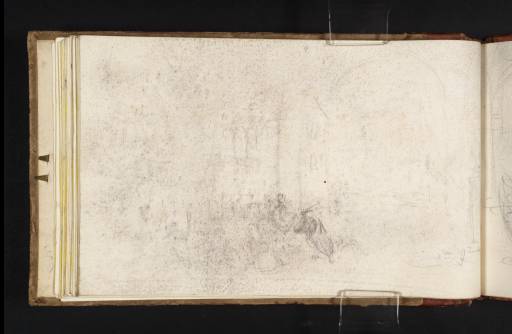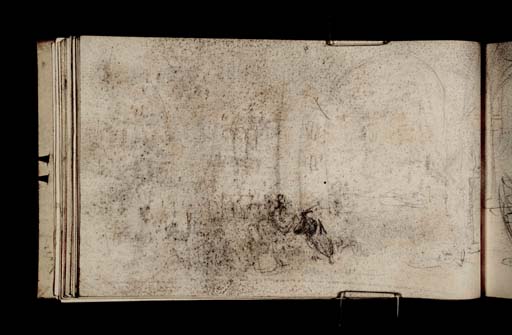Joseph Mallord William Turner An Artist in the Vatican Loggia: Composition Study for 'Rome from the Vatican' 1819
Image 1 of 2
Joseph Mallord William Turner,
An Artist in the Vatican Loggia: Composition Study for 'Rome from the Vatican'
1819
Joseph Mallord William Turner 1775–1851
Folio 25 Verso:
An Artist in the Vatican Loggia: Composition Study for ‘Rome from the Vatican’ 1819
D14971
Turner Bequest CLXXIX 25 a
Turner Bequest CLXXIX 25 a
Pencil on white wove paper, 112 x 186 mm
Accepted by the nation as part of the Turner Bequest 1856
References
1909
A.J. Finberg, A Complete Inventory of the Drawings of the Turner Bequest, London 1909, vol.I, p.527 as ‘Design for picture of Raffael and La Fornarina in the Logge. (Cf. “Rome from the Vatican,” exhibited R.A., 1820’).
1965
Jerrold Ziff, ‘Copies of Claude’s Paintings in the Sketch Books of J.M.W. Turner, Gazette des beaux-arts, vol.65, January 1965, pp.56, 64 note 24.
1974
Martin Butlin, Andrew Wilton and John Gage, Turner 1775–1851, exhibition catalogue, Royal Academy, London 1974, p.92 under no.236.
1982
Evelyn Joll and Martin Butlin, L’opera completa di Turner 1793–1829, Classici dell’arte, Milan 1982, p.107 under no.228.
1984
Martin Butlin and Evelyn Joll, The Paintings of J.M.W. Turner, revised ed., New Haven and London 1984, p.137 under no.228.
1984
Cecilia Powell, ‘Turner on Classic Ground: His Visits to Central and Southern Italy and Related Paintings and Drawings’, unpublished Ph.D thesis, Courtauld Institute of Art, University of London 1984, pp.149, 235, 239.
1986
Gerald Finley, ‘J.M.W. Turner’s “Rome from the Vatican”: A Palimpsest of History?’, Zeitschrift ür Kunstgeschichte, vol.49, 1986, pp.58, 59–60, reproduced pl.3, as ‘Sketch composition (pencil) for “Rome from the Vatican” ’).
1987
Robert E. McVaugh, ‘Turner and Rome, Raphael and the Fornarina’, Studies in Romanticism, no.26, Autumn 1987, pp.372, 373, 383–4.
1992
Maurice Davies, Turner as Professor: The Artist and Linear Perspective, exhibition catalogue, Tate Gallery, London 1992, p.112 note 89.
1997
James Hamilton, Turner: A Life, London 1997, p.199 note 16.
1999
Gerald Finley, Angel in the Sun: Turner’s Vision of History, Montreal and Kingston [Canada] 1999, pp.41–2 note 70.
2008
James Hamilton, Nicola Moorby, Christopher Baker and others, Turner e l’Italia, exhibition catalogue, Palazzo dei Diamanti, Ferrara 2008, p.49.
2009
James Hamilton, Nicola Moorby, Christopher Baker and others, Turner & Italy, exhibition catalogue, National Galleries of Scotland, Edinburgh 2009, p.49.
2009
Ian Warrell, ‘Painters Painted: The Cult of the Artist’, in David Solkin (ed.), Turner and the Masters, exhibition catalogue, Tate Britain, London 2009, pp. 229 note 1 under no.63, 230 note 1 under nos.64–5.
2010
David Solkin and Guillaume Faroult (eds.), Turner et ses peintres, exhibition catalogue, Galeries nationales, Grand Palais, Paris 2010, pp.196, 198, 262 notes 12 and 19.
In addition to compiling a detailed visual record of the southern end of the Loggia of Raphael in the Vatican, see folios 13 verso–21 (D14955–D14965), Turner also made two compositional sketches exploring the theme of an artist working in the building. From these drawings evolved the artist’s first finished oil painting following his Italian tour, the vast canvas Rome from the Vatican. Raffaelle Accompanied by La Fornarina, Preparing his Pictures for the Decoration of the Loggia exhibited 1820 (Tate, N00503).1 In marked contrast to the carefully observed and annotated studies of the decorative and architectural elements of the loggia, the rough, free execution of these drawings belies their imaginary, conceptual nature. Although obviously related in theme and appearance, the two sketches reveal different strategies for the depiction of the figure of Raphael within the foreground of the finished picture.
This sketch has been described as the ‘weaker’ of the two compositional studies, partly due to its smudged, indistinct surface, and the off-setting of the darker image from the opposite sheet of the double-page spread, see folio 26 (D14972).2 Yet, despite the vagueness of the lines, the design clearly shows a male figure seated within the setting of the Loggia of Raphael. Identifiable in the background is an arched window of the loggia arcade, the façade of the opposite wing of the Apostolic Palace and part of the cityscape beyond.3 The archaic dress and dark floppy hat suggest that the figure is an artist, whilst behind him to the left is the suggestion of a nude female model, possibly intended to represent Raphael’s mistress and muse, La Fornarina. Unlike the standing, active figure evident within the second design, the artist in this scene appears passive and contemplative, leaning his head on his arm and possibly gazing upwards. Robert McVaugh has suggested that Turner may have been referencing an engraving of Raphael by Marcantonio Raimondi (circa 1480–1534).4 The spirit of the pose is close to that of Raphael in Rome from the Vatican, who, despite the fact that he is standing, supports his head with his hand whilst contemplating the vaults of the loggia above.
Further studies related to the evolution of Rome from the Vatican can be found on folios 21 verso, and 24–25 (D14966 and D14969–D14970), as well as an elaborate compositional drawing in pen and ink in the Rome C. Studies sketchbook (Tate D16368; Turner Bequest CLXXXIX 41).
Nicola Moorby
January 2010
How to cite
Nicola Moorby, ‘An Artist in the Vatican Loggia: Composition Study for ‘Rome from the Vatican’ 1819 by Joseph Mallord William Turner’, catalogue entry, January 2010, in David Blayney Brown (ed.), J.M.W. Turner: Sketchbooks, Drawings and Watercolours, Tate Research Publication, December 2012, https://www


